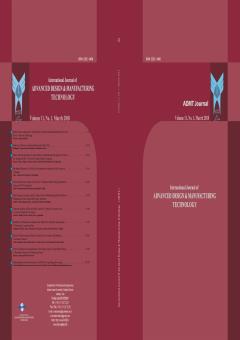Application of Adaptive Neuro Fuzzy Inference System (ANFIS) for prediction the hardness of CK45 based on hot rolling parameters
محورهای موضوعی : Mechanical Engineeringaydin salimi 1 , Esmaeil Seidi 2 , مجتبی مروج 3
1 - University of Peyame noor
2 - Payame Noor University of Tabriz
3 - عضو هیات علمی دانشگاه پیام نور خوزستان
کلید واژه: Hot rolling, Mechanical properties, rolling parameters, CK45, ANFIS,
چکیده مقاله :
Rolling stands as a crucial manufacturing technique that offers the dual benefit of enhancing steel's mechanical characteristics. Given the substantial time investment and financial burden associated with rolling experiment setups, implementing predictive models for mechanical properties can enhance precision while reducing both temporal and monetary costs. This study conducted hot rolling experiments on CK45 steel across two distinct environments. The specimens underwent rolling at five different temperature levels and five varying work-roll rotation speeds, maintaining consistent reduction percentages. Following the rolling process, the samples were rapidly cooled in ambient air and cold water conditions, with hardness measurements obtained using specialized testing equipment. The research employed the Adaptive Neuro-Fuzzy Inference approach to forecast hardness values based on operational parameters. The model utilized rolling temperature and rotational speed of the rollers as input variables, while the hardness measurements post-quenching in both air and water environments served as output data. The analysis yielded R² values exceeding 0.99 between measured and predicted results for both environments, demonstrating ANFIS's effectiveness in accurately predicting sample hardness across various rolling speeds and temperatures.
[1] Ray, S., "Introduction to Rolling Process," in Principles and Applications of Metal Rolling. Cambridge: Cambridge University Press, 2016, pp. 1-29.
[2] Wang, S.-F., Peng, Y. a., and Zhi-Jie, L., "Work-Hardening and Deformation Mechanism of Cold Rolled Low Carbon Steel", Research Journal of Applied Sciences, Engineering and Technology, vol. 5, No. 3, 2013, pp. 823-828.
[3] Zhang, X., Wang, H., Scattergood, R. O., Narayan, J., and Koch, C. C., "Modulated oscillatory hardening and dynamic recrystallization in cryomilled nanocrystalline Zn", Acta Materialia, vol. 50, No. 16, 2002, pp. 3995-4004.
[4] Ueji, R., Tsuji, N., Minamino, Y., and Koizumi, Y., "Effect of rolling reduction on ultrafine grained structure and mechanical properties of low-carbon steel thermomechanically processed from martensite starting structure", Science and Technology of Advanced Materials, vol. 5, No. 1-2, 2004, pp. 153-162.
[5] Sun, J.-J., Lian, F.-L., Liu, H.-J., Jiang, T., Guo, S.-W., Du, L.-X., and Liu, Y.-N., E-mail: ynliu@mail.xjtu.edu.cn, "Microstructure of warm rolling and pearlitic transformation of ultrafine-grained GCr15 steel", Materials Characterization, 2014, pp. Medium: X; Size: page(s) 291-298.
[6] Niakan, H. and Najafizadeh, A., "Effect of niobium and rolling parameters on the mechanical properties and microstructure of dual phase steels", Materials Science and Engineering: A, vol. 527, No. 21, 2010, pp. 5410-5414.
[7] Zebarjadi Sar, M., Barella, S., Gruttadauria, A., Mombelli, D., and Mapelli, C., "Impact of Warm Rolling Process Parameters on Crystallographic Textures, Microstructure and Mechanical Properties of Low-Carbon Boron-Bearing Steels", Metals, vol. 8, No. 11, 2018, p. 927.
[8] Nwachukwu, P. U. and Oluwole, O. O., "Effects of rolling process parameters on the mechanical properties of hot-rolled St60Mn steel", Case Studies in Construction Materials, vol. 6, 2017, pp. 134-146.
[9] Abdul Syukor Mohamad Jaya, A. S. H. B., Siti Zaiton Mohd Hashim, Habibollah HaronMuhd, Razali Muhamad and Md. Nizam Abd. Rahman, "Application of ANFIS in Predicting of TiAlN Coatings Hardness", Australian Journal of Basic and Applied Sciences, vol. 5, No. 9, 2011, pp. 1647-1657.
[10] Khalaj, G., Nazari, A., and Livary, A. K., "Application of ANFIS for modeling of microhardness of high strength low alloy (HSLA) steels in continuous cooling", Materials Research, vol. 16, No. 4, 2013, pp. 721-730.
[11] Ly, Pham, Dao, and Le, "Improvement of ANFIS Model for Prediction of Compressive Strength of Manufactured Sand Concrete", Applied Sciences, vol. 9, No. 18, 2019, p. 3841.
[12] Zare, M. and Vahdati Khaki, J., "Prediction of mechanical properties of a warm compacted molybdenum prealloy using artificial neural network and adaptive neuro-fuzzy models", Materials & Design, vol. 38, 2012, pp. 26-31.
[13] Le, L. M., Ly, H.-B., Pham, B. T., Le, V. M., Pham, T. A., Nguyen, D.-H., Tran, X.-T., and Le, T.-T., "Hybrid Artificial Intelligence Approaches for Predicting Buckling Damage of Steel Columns Under Axial Compression", Materials, vol. 12, No. 10, 2019, p. 1670.
[14] Yadollahi, M. M., Benli, A., and Demirboga, R., "Application of adaptive neuro-fuzzy technique and regression models to predict the compressive strength of geopolymer composites", Neural Computing and Applications, vol. 28, No. 6, 2016, pp. 1453-1461.
[15] Ginarsa, I. M., Nrartha, I. M. A., Muljono Agung, B., and Ardana, I. P., "Application of Adaptive Neuro-Fuzzy Inference System Control in Power Systems," in Adaptive Neuro-Fuzzy Inference System as a Universal Estimator, V. Constantin Ed. Rijeka: IntechOpen, 2024, p. Ch. 4.
[16] Mohammadi, K., Shamshirband, S., Petković, D., Yee, P. L., and Mansor, Z., "Using ANFIS for selection of more relevant parameters to predict dew point temperature", Applied Thermal Engineering, vol. 96, 2016, pp. 311-319.
[17] Khalaj, G., Nazari, A., and Livary, A. K., "Application of ANFIS for modeling of microhardness of high strength low alloy (HSLA) steels in continuous cooling", Materials Research-ibero-american Journal of Materials, vol. 16, 2013, pp. 721-730.


